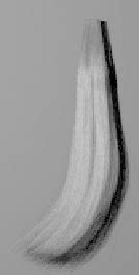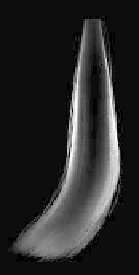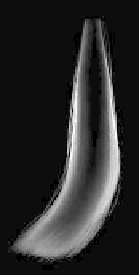Graphics Reference
In-Depth Information
(a) Particle simulation method (b) Spherical harmonics method
Figure 8.63
Comparison of image rendered using (a) the photon mapping method, and (b) the spherical
harmonics method. The images on the right are lit from behind.
(From [Moon et al. 08]
c
2008 ACM, Inc. Included here by permission.)
many fibers, so the SH coordinate system is left in the “neutral” coordinate system
of the grid.
17
Using spherical harmonics in this way reduces the computation of the scatter-
ing integral (see Section 3.3.2) to a simple matrix multiplication. As a result, the
process is much faster than the volumetric photonmapping and dramatically faster
than a brute-force path-tracing approach. Figure 8.63 contains a pair of images,
one lit from the front, and one lit from the back, rendered with the photon map
method described in the 2006 paper and the corresponding images rendered using
the spherical harmonics approach. The images are practically indistinguishable,
but the SH implementation runs about 10 times faster.
Martin Hill and his colleagues at Weta Digital began implementing these two-
pass methods for rendering hair starting in 2007. They established an efficient
GI rendering pipeline based on the concept of precomputed radiance transfer (see
Section 10.5), which they applied to the production of the movie
Avatar
.
8.5.2 An Analytical Approach.
In 2008, another method for efficiently rendering multiple scattering in hair was
presented in the paper “Dual Scattering Approximation for Fast Multiple Scatter-
ing in Hair” by Arno Zinke, Cem Yuksel, Andreas Weber, and John Keyser [Zinke
et al. 08]. The approach described in this paper does not employ simulations;
rather, it analytically derives functions to approximate multiple scattering behav-
17
The details of the scattering matrix and its relationship to spherical harmonic basis functions is
covered in Section 10.2.2.













